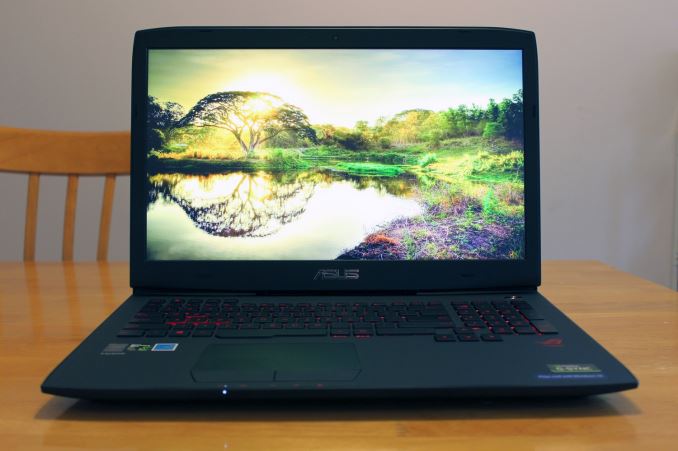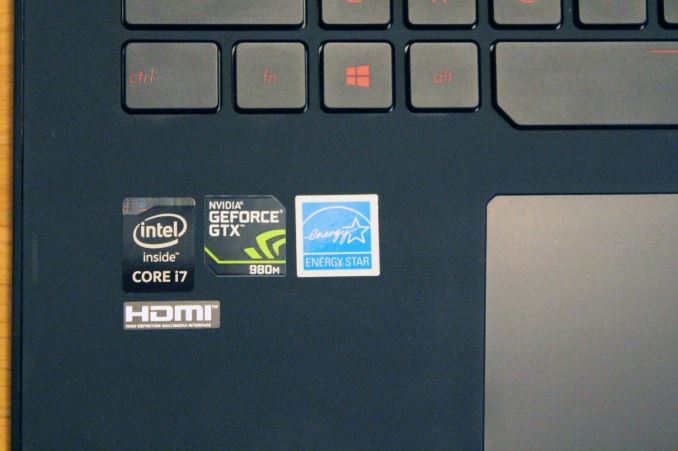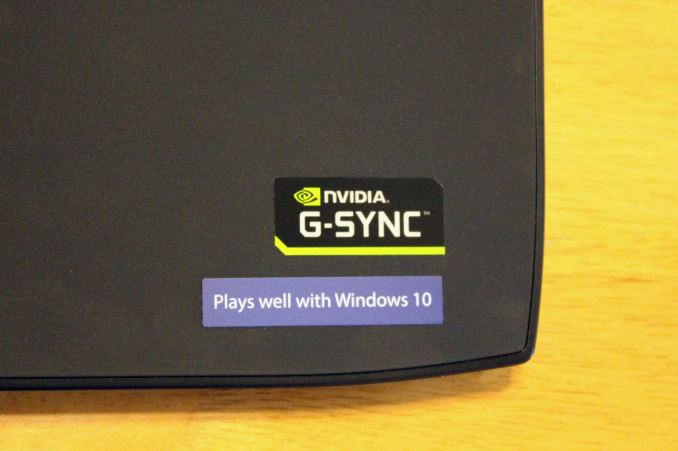The ASUS Republic of Gamers G751 Review: G-SYNC Comes To The Notebook Computer
by Brett Howse on July 29, 2015 8:30 AM EST
At Computex 2015, NVIDIA announced what will almost certainly be one of their marquee features on gaming notebooks going forward, with NVIDIA’S G-SYNC variable display refresh rate technology coming to notebooks. We’ll dive into this more in a bit, but perhaps the best part of the announcement was that it was going to be a hard launch, with several vendors offering notebooks featuring G-SYNC right away.
One of those was ASUS, and NVIDIA shipped me the ASUS G751JY model with G-SYNC to take a look at. The G751 was first introduced in October 2014. It is a 17.3-inch laptop targeted towards gamers under ASUS’s Republic of Gamers (ROG) branding. ASUS these days seems to have a focus on offering value, and by that I mean they often offer more computer for your money than most other brands. The ASUS Zenbook UX305 is a perfect example of this, offering excellent performance, specifications, and build materials for much less than the competition. Of the initial announcements of G-SYNC notebooks, ASUS has certainly come in with a lot of value here too.
The G751 has a couple of configuration options, with the G751JT model featuring the GTX 970M and G-SYNC, but this review is on the higher end G751JY model, which features the Intel Core i7-4720HQ processor, with four cores and eight threads available in a 47 Watt envelope. In order to have G-SYNC, you will need a NVIDIA GPU, and the JY model features NVIDIA's highest end mobile GPU, the GTX 980M, with 4 GB of memory onboard the graphics card. System memory is 24 GB on the model I received, with 3x8GB of DDR3L-1600, and a 256 GB SSD, which is the very fast Samsung XP941 PCIe model, and a 1 TB 7200 RPM drive for extra storage. Although optical media is certainly on the way out, with a 17.3-inch notebook there is plenty of room for an optical drive, and the G751JY features a 6x Blu-Ray writer.
| ASUS ROG G751JY | |||||
| As Tested, Core i7-4720HQ, 24 GB RAM, 256 GB SSD + 1TB HDD | |||||
| Processor | Intel Core i7-4720HQ (4C/8T, 2.6-3.6GHz, 6MB L3, 22nm, 47W) Intel Core i7-4870HQ (4C/8T, 2.5-3.7GHz, 6MB L3, 22nm, 47W) |
||||
| Memory | 24GB-32GB DDR3L-1600 MHz | ||||
| Graphics | NVIDIA GTX 980M 4GB | ||||
| Display | 17.3" 1920x1080 IPS Matte, 75Hz, G-SYNC | ||||
| Storage | 256GB-512GB Samsung XP941 PCIe SSD 1 TB 7200rpm HDD |
||||
| Networking | Intel Dual Band Wireless-AC 7260 Realtek 1 Gbps Ethernet |
||||
| Audio | Waves MAXX Audio Two speakers plus subwoofer |
||||
| Battery | 90 Wh Battery 230 Watt A/C Adapter |
||||
| Right Side | 2 x USB 3.0 Ports Headphone Jack Microphone Jack DisplayPort HDMI VGA SPDIF (3.5mm) |
||||
| Left Side | 2 x USB 3.0 Ports SD Card Reader Blu-Ray Burner |
||||
| Dimensions | 317.5 x 416.6 x 43.2mm (12.50 x 16.40 x 1.70 inches) | ||||
| Weight | 3.81 kg (8.4 lbs) | ||||
| Extras | 720p Webcam Backlit Keyboard |
||||
| Pricing | $2150 MSRP (i7-4720HQ, 24GB, 256GB SSD) Amazon.com $1900 $2650 MSRP (i7-4870HQ, 32GB, 512GBSSD) Amazon.com $2460 |
||||
A laptop that comes in at over $2000 may seem like a difficult thing to consider as a value play, but once again ASUS has really packed in a lot of performance for the price. For a bit more money, you can add in another 8 GB of memory and double the SSD capacity to 512 GB if you want to keep less of your data on the spinning disk. If you want G-SYNC with a GTX 980M, the ASUS offers a pretty good price to performance ratio.
At 8.4lbs, or 3.8 kg, this is no lightweight laptop, but there is certainly a market for people who want a desktop replacement-style laptop with lots of performance and a big display. The larger chassis is a bit more of a hassle to move around, but the extra display size makes for a very good gaming experience, and the larger chassis of a 17.3-inch notebook provides an opportunity for better system cooling with less noise. We’ll see how it measures up to the competition, with the MSI GT72 Dominator Pro likely being its direct competitor.












52 Comments
View All Comments
nathanddrews - Wednesday, July 29, 2015 - link
Does Intel plan on taking advantage of the Adaptive Sync tech anytime soon? I know they use it for other things for power saving (self-refresh, etc.), but it sure seems like a golden opportunity.In the same vein - given that we know (and have known for some time) that the G-Sync module is not required if you have eDP/DP1.2a, when can we expect a shift to tech-agnostic displays? Do we have to wait for DP1.3?
DanNeely - Wednesday, July 29, 2015 - link
I know eDP/DP1.2a provides a similar feature set to G-Sync; but has nVidia actually said anything about adopting it instead of (in addition to?) their current custom hardware implementation?DanNeely - Wednesday, July 29, 2015 - link
I suppose I deserve what I get for commenting before reading the 2nd page of the article; but as long as they're requiring additional qualification work to approve a panel for GSync, there's still plenty of potential to cause trouble for cross GPU support if they wanted to.nathanddrews - Wednesday, July 29, 2015 - link
VESA's Adaptive Sync is a part of eDP and DP 1.2a+. It's there, waiting to be used. G-Sync, FreeSync, and whatever Intel does are just the names for how they utilize it.The only reason NVIDIA pursued a custom module was because no desktop monitors - at the time - included A-Sync. Screens connected via eDP can. As we move forward with newer and newer displays, we're likely to see more and more of them be A-Sync-capable, which means being able to support any variable refresh technology, whatever the marketing label is. Whether or not those displays end up as G-Sync, FreeSync, or some sort of hybrid is up to the manufacturers, I suppose. Just like with G-Sync and FreeSync displays, optimizing the display will still be important.
Ideal situation: connect monitor to computer, GPU drivers load a default profile based upon EDID for frequency range and resolution support, advanced users can tweak (under/overclock/etc.), maybe share firmware, etc. to crowd-source calibration settings. Shipping a monitor back to a manufacturer for an update is ridiculous...
lefty2 - Thursday, July 30, 2015 - link
> The only reason NVIDIA pursued a custom module was because no desktop monitors - at the time - included A-Sync.This is not true. When AMD created FreeSync the DisplayPort 1.2a monitors did not exist either, but instead of creating a propierty solution, they got FreeSync incorperated into the open standard. Nvidia could have done the same thing, but they prefer using propierty standards to lock the customers in.
nathanddrews - Thursday, July 30, 2015 - link
Interesting version of history you've created.DP1.2a display availability lagged behind G-Sync Module display availability by more than a year. If NVIDIA pursued the VESA solution, G-Sync would have been delayed alongside FreeSync. The G-Sync module was absolutely required to get a jump on the market since DP1.2 did not include the Adaptive Sync option. You may not LIKE it, but that's the how it happened.
lefty2 - Thursday, July 30, 2015 - link
DP1.2a display availability also lagged behind FreeSync... AMD just waited had to wait for them to come available (in fact they pushed the standard forward) and Nvidia could have done the same.LoganPowell - Friday, November 27, 2015 - link
ASUS does overall make fantastic computers, but I'd recommend going for the Dell Inspiron i7559-763BLK. Highly approved by many gaming enthusiasts. /Logan from http://www.consumerrunner.com/top-10-best-laptops/Creig - Thursday, July 30, 2015 - link
"additional qualification" = give us money to use the G-sync name.Shadowmaster625 - Wednesday, July 29, 2015 - link
I have a great idea. Let's build Optimus notebooks for five years, and then all the sudden build one without it! Isnt that a great frickin idea? I need to be CEO of Asus.